Austria is perfect for sightseeing, with an assortment of wonderful tourist attractions. Just the mention of this scenic, multicultural country brings to mind images of skiing in the Alps, exploring Vienna's impressive Baroque architecture, and sampling the warm, rich cuisine of the alpine villages and their friendly inhabitants.Austria is the birthplace of many famous figures, including Wolfgang Amadeus Mozart and Sigmund Freud, not to mention Arnold Schwarzenegger. Austria is also home to Swarovski crystals, Lipizzaner stallions, and the 11th-century Hohensalzburg Fortress, as well as one of the largest youth parties in Europe, the Danube Island Festival.Austria is a year-round destination, with snowy winters perfect for mountaineering, skiing, and snowboarding, and mild summers ideal for sightseeing. The many sights and attractions are made accessible by the national railway system, the U-Bahn, extensive motorways, and various ports and harbours. With all these magnificent highlights so easily within grasp, taking a trip to this beautiful country in the warm heart of Europe is guaranteed to be a fulfilling, memorable experience for anyone.
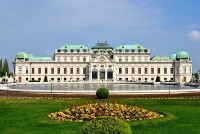
The Belvedere consists of two splendid rococo mansions, designed in the early 18th century, which face each other across formal, sloping grounds offering excellent views over the city. From the outside, it is Vienna's finest palace complex, built by Prince Eugène of Savoy, the famous general who saved Vienna from the advance of the Ottoman Empire.The museums in the two palaces house some of Vienna's most renowned art galleries, offering excellent examples of Austrian art from the middle ages to the present day. Their displays include an unrivalled collection of paintings by Klimt, as well as famous works by Schiele, Kokoschka, Renoir, and Monet. The Medieval and Baroque works are presented in the Lower Palace where many rooms have been preserved in their original state.
Address : 27 Prinz Eugen Street
Website : www.belvedere.at
Telephone : +43 1795 570
Transport : Upper Belvedere: Tram D to Schloss Belvedere or Trams 18 or 0 to Südbahnhof; bus 13A or 69A to Südbahnhof
Opening times : Daily 10am to 6pm. Lower Belvedere and the Orangery open until 9pm Fridays. Upper Belvedere opens at 9am daily.
Admission : €20 for a combination ticket, giving access to upper and lower Belvedere (adult), children free. Concessions available.
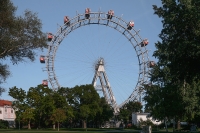
One of Vienna's most recognisable landmarks, the Giant Wheel is located in a large wooded park and playground known as the Prater. It was built in 1897 by an English engineering firm and is the only one of its era still standing (the Ferris wheels in Chicago, London, Blackpool, and Paris have long since been destroyed).The wheel's 15 gondolas take 20 minutes to manoeuvre around and offer magnificent panoramic views of the city. Cautious visitors need not worry about the age of the Giant Wheel as it has been very well maintained over the decades! This is a fun attraction for the whole family and will delight children.
Address : Prater 90
Website : www.wienerriesenrad.com
Telephone : (0)1 729 5430
Opening times : Open daily but hours vary seasonally, see website for details.
Admission : €10 (adults), €4.50 (children 3-14), concessions available.
The Hofburg Palace, or Imperial Palace, was the home of the Austrian Hapsburgs for 600 years. The first fortifications were erected by King Ottakar Premyst in the 13th century and were added to by every generation until it became the monumental structure it is today.As well as housing the president's offices, the palace now encompasses 22 separate museums, the National Library, a 14th-century Augustinian church, the famous Spanish Riding School, and the Royal Chapel, where every Sunday the Vienna Boys Choir sing Mass (they have performed for the Royal Court since 1498).It will be impossible to even catch a glimpse of everything on display at the Hofburg, so visitors should be selective. The most popular of the museums is the Kaiserappartements, which takes visitors on a tour of the Kaiser's imperial apartments, the Sisi Museum, and the Imperial Silver Collection.Situated in the Hofburg Palace, the royal library of the Habsburgs dates from the 14th century and is among the oldest and finest libraries in the world. The six million items stored in the library include papyri, manuscripts, ancient and rare books, maps, globes, portraits, music, photographs, and graphics. The Grand Hall is a palatial room topped by a dome, designed in the Baroque style and decorated with statues and exquisite frescoes. It's regarded as one of the most beautiful library rooms in the world.
Address : Innerer Burghof 1, Kaisertor
Website : www.hofburg-wien.at
Telephone : (0)1 533 7570
Transport : U-Bahn to Herrengasse; tram D, J, 1 or 2 to Burgring; bus 2A or 3A to Hofburg
Opening times : Daily 9am to 5.30pm (September to June), 9am to 6pm (July to August).
Admission : €13.90 (adults), €8.20 (children 6-18); other concessions available. Price includes audio guide.
The magnificent Schönbrunn Palace was used as the summer residence of the Hapsburgs from the 18th century onwards. Set among superb gardens, this vast symmetrical structure is everything you would imagine an imperial palace to be.A tour of the palace offers visitors the chance to view the superb assortment of Baroque and Rococo State Rooms and to admire the famous ceiling frescoes of the Great Gallery and the Hall of Mirrors where Mozart once played.The vast gardens are popular with locals and tourists alike, and include a zoo, a maze, and labyrinth, the Privy garden, and the Gloriette with a viewing terrace. Also within the grounds, the Orangery hosts classical concerts during the summer season.
Address : Schönbrunner Schloss Strasse 13
Website : www.schoenbrunn.at
Telephone : +43 1 811 130
Transport : U4 to Schönbrunn station, trams 10 or 60, Bus 10A
Opening times : 8.30am - 5.30pm April to June, 8.30am - 6.30pm July to August, 8.30am - 5.30pm September to November, and 8.30am - 5pm November to March.
Admission : Grand Tour with audio guide: €17.50 (adults). Various other tour options available.
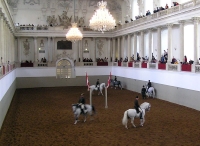
The Spanish Riding School of Vienna is one of the oldest surviving riding schools in the world where classic dressage is still practised in its purest form. This institute was founded in 1572 and named for the Lipizzaner horses, which are of Spanish origin. The Imperial Court Stud was originally situated near the village of Lipizza, hence the name of the horses. But since the collapse of the Danube Monarchy in 1920, they have been bred at the Federal Stud in Styria.The horses perform their tricks in the Winter Riding School, which was commissioned by Emperor Karl VI. Performances take place between February and June, and September and December. But they are in high demand and booked up months in advance (details on their website). The easiest way to see the horses is during their training sessions. Tickets are only available at the door and cannot be booked in advance. Situated in the stables is the Lipizzaner Museum, which displays the history of the school.
Address : Michaelerplatz 1
Website : www.spanische-reitschule.com
Telephone : +43 1 533 90 310
Transport : U-Bahn to Herrengasse, or tram D, J, 1 or 2 to Burgring
Opening times : Daily 9am to 4pm. Performances Fridays 9am to 7pm. Check the official website to confirm show times.
Admission : Prices vary according to season, attraction and seating options; see website for details.
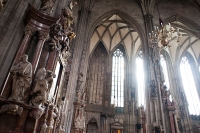
The cathedral is one of the city's most recognisable symbols and the massive south tower, standing at 445 feet (136m) tall, is a dominant feature on the Vienna skyline. The 343 steps can be climbed for a fantastic view over the city.St Stephan's Cathedral is the most important religious building in the city and is one of the greatest Gothic structures in Europe. It has been in a state of continual preservation and repair since its original construction in the 12th century due to fire, city sieges, and bombardment.The cathedral is built of limestone and has an ornately patterned and richly coloured roof covered by glazed tiles. The interior is rich in wood carvings, sculptures, and paintings, and has numerous chapels and altars, as well as the catacombs, which can be visited on a guided tour. Wolfgang Amadeus Mozart was married here, had children baptised here, and his funeral was held in the Chapel of the Cross.
Address : Stephansplatz
Website : www.stephanskirche.at
Telephone : Guided tours: (+43) 151 552 3054
Transport : U-Bahn to Stephansplatz
Opening times : Daily 6am to 10pm (from 7am on Sundays). Various guided tours take place daily.
Admission : Free admission to the cathedral. All-inclusive Cathedral Tour: €19.90 (adults). Other packages and concessions available.
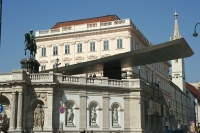
The former Hofburg residence today houses one of the largest and greatest graphic art collections in the world with drawings, old master prints, and modern graphic works. The museum explores the development of graphic arts since the 14th century and there are more than 60,000 works on show.Artists featured include Leonardo da Vinci, Michaelangelo, Manet, Picasso, and Cezanne. The Albertina is also one of the most beautiful examples of classical architecture in the world. There is a pleasant cafe for refreshments while the museum is beautifully conceived, with each room decorated to complement the art on display.
Address : Albertinaplatz 1
Website : www.albertina.at
Telephone : +43 1 534 830
Opening times : Daily 10am to 6pm (until 9pm on Wednesdays).
Admission : €12.90 (adults), concessions available. Children under 19 free.
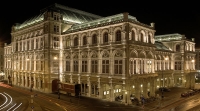
The Vienna State Opera performs a repertoire of nearly one hundred operas, operettas, and ballets every day from September to June. The opera house was founded in the early 18th century (it was rebuilt in 1955 after being all but destroyed in 1945) and makes for a romantic and regal setting in which to enjoy the performances.As seating tickets are not easily available, an alternative is to buy standing-room tickets, which are well priced and can be purchased on the same day (but expect long queues). The State Opera collaborates closely with the Vienna Philharmonic Orchestra and their famous New Year concert requires advance bookings of up to one year. The building is beautiful and of interest in itself, even if visitors are unable to catch a show.
Address : Opernring 2
Website : www.wiener-staatsoper.at
Telephone : (+43)1 51444 2250
Transport : Take the U-Bahn lines U1, U2, U4 or the 59A bus to Karlsplatz or Oper stations
Opening times : Guided tours are offered Tuesday to Sunday; check dates and times online or via telephone
Admission : Combination tickets for tour and museum are available and come at varied prices, check website for details. Concessions available.

Travel Guide powered by Word Travels, copyright © 2023 Globe Media Ltd. By its very nature information in this travel guide is subject to change at short notice and travellers are urged to verify information on which they're relying with the relevant authorities. Neither Globe Media Ltd nor Travel Vogue can accept any responsibility for any loss or inconvenience to any person as a result of information contained above.